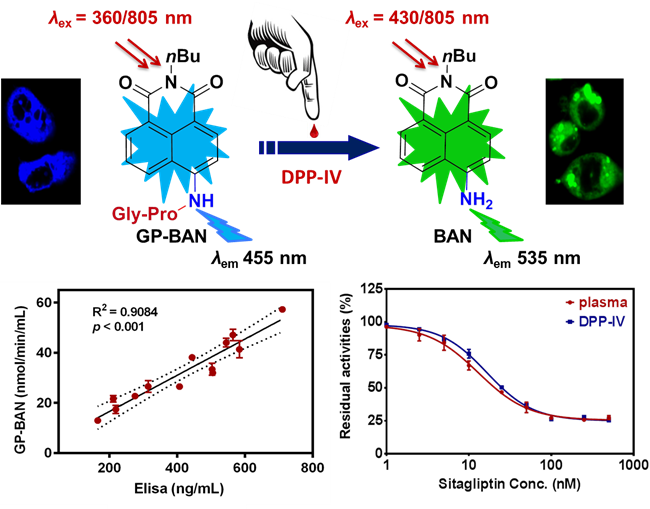Dipeptidyl peptidase IV (DPP-IV, CD26) is a multifunctional serine protease enzyme with key roles in the control of endocrine and immune function, cell metabolism, growth and adhesion. It is a famous therapeutic target for the treatment of type-2 diabetes. DPP-IV also exhibits co-stimulatory role in T-cell activation, adhesion to extracellular matrix proteins, and serves as the functional receptor for Middle East respiratory syndrome coronavirus infection.
DPP-IV now has becoming the center of attention as a novel molecular marker or a potential therapeutic target for cancer. Furthermore, increasing evidence has demonstrated that the abnormal presence or altered level of DPP-IV in plasma can serve as a potential biomarker for early diagnosis and prognosis evaluation of many diseases. Thus, the accurate measurement of DPP-IV in complex biological samples, especially in plasma, is of great importance for disease diagnosis, drug discovery and clinical practice.
The Pharmaceutical Resource Discovery Group led by Prof. GE Guangbo and Prof. YANG Ling in DICP developed a highly specific ratiometric two-photon fluorescent probe GP-BAN. It was successfully used for detection of dipeptidyl peptidase IV in plasma and two-photon imaging of endogenous DPP-IV in living cells and tissues.

Figure. Proposed response mechanism of the GP-BAN/BAN system for DPP-IV detection (Imaged by ZOU Liwei)
In this study, Gly-Pro-BAN (GP-BAN) was designed on the basis of the catalytic properties and substrate preference of DPP-IV. It could be readily hydrolyzed upon addition of DPP-IV under physiological conditions. GP-BAN displayed good reactivity and high selectivity towards DPP-IV over other human serine hydrolases including FAP, DPP-VIII, and DPP-IX. It was evidenced by both reaction phenotyping and inhibition assays. Furthermore, GP-BAN was successfully used to monitor the real activities of DPP-IV in complex biological systems including tissue preparations, plasma and living cells.
Meanwhile, GP-BAN could serve as a promising tool for high-throughput screening of DPP-IV inhibitors by using human plasma and tissue preparations as enzyme source. This is the first report to screen DPP-IV inhibitors by using readily available human plasma as enzyme source. GP-BAN was also successfully used for two-photon imaging of endogenous DPP-IV in living cells and tissues, and showed low cytotoxicity, high ratiometric imaging resolution and deep-tissue penetration ability. Thus, the fluorescent probe GP-BAN could serve as a promising imaging tool to explore the biological functions and physiological roles of this key enzyme in living systems.
The related results were published in Biosensors and Bioelectronics. (DOI: 10.1016/j.bios.2016.11.068).This work was supported by Natural Science Foundation of China and National Basic Research Program of China. (Text and Imaged by ZOU Liwei)
Dr. LU Xinyi
Dalian Institute of Chemical Physics, Chinese Academy of Sciences,
457 Zhongshan Road, Dalian, 116023, China,
Tel: 86-411-84379201,
E-mail: luxinyi@dicp.ac.cn